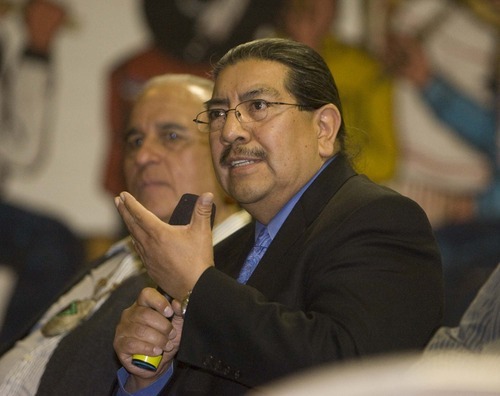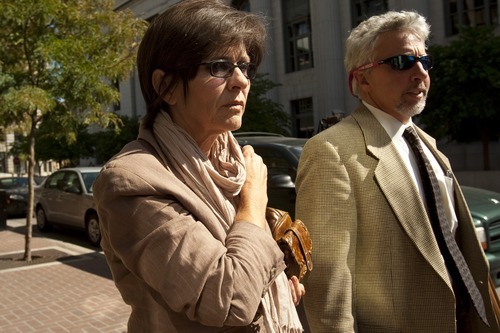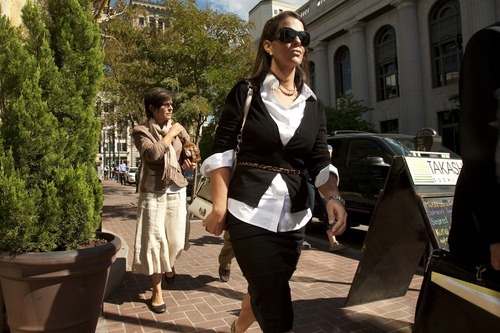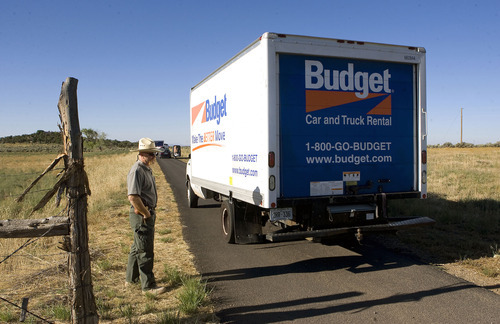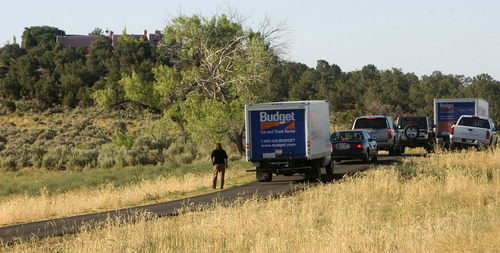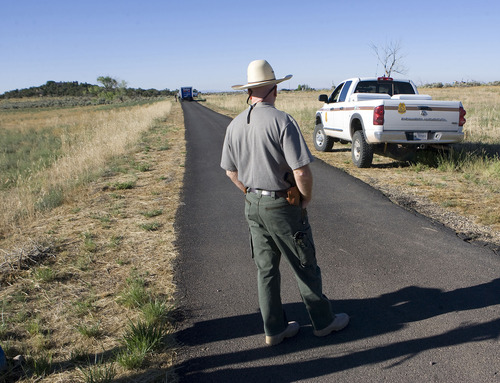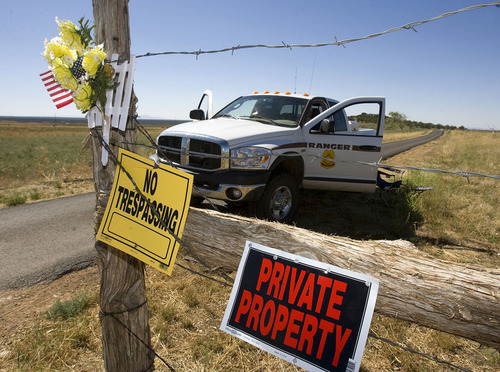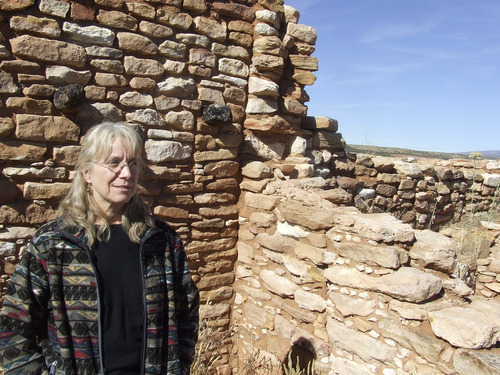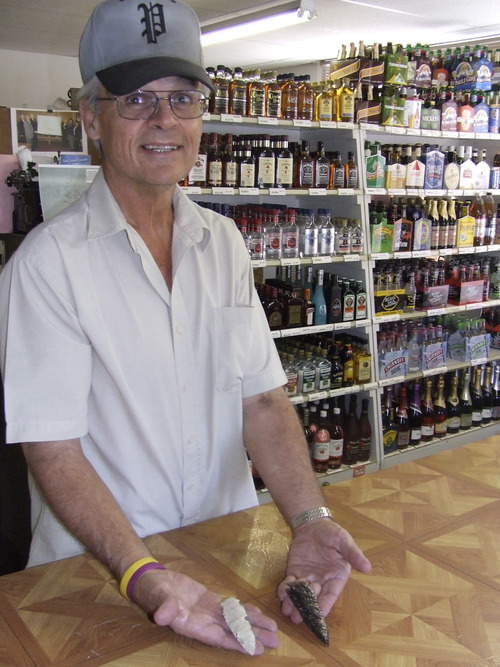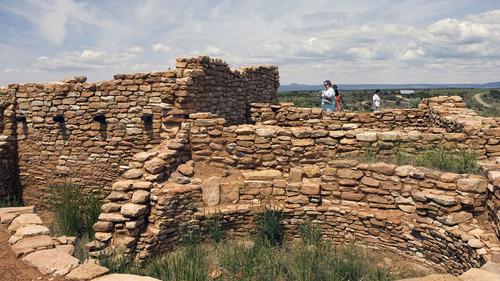This is an archived article that was published on sltrib.com in 2011, and information in the article may be outdated. It is provided only for personal research purposes and may not be reprinted.
Blanding • A caravan of well-armed federal agents rolled into this town in June 2009 to shackle and haul away a score of southern Utahns who allegedly had turned a century-old pot-hunting hobby into a lucrative black market in American Indian artifacts.
The artful simplicity of those black zigzags, squares and diamonds — painted on white clay pots a millennium ago — holds the timeless allure of a link in the human chain. But Congress decreed in 1906 that what remained in the earth on federal lands belonged to science and posterity, not on living-room mantels. And, in Utah's Four Corners region, the largest-ever push to enforce that decree and subsequent laws would provoke a tragic clash of cultures.
The laws, the arrests, the penalties — nothing has stopped the criminal trafficking, last year or last century. Over time, many archaeologists and prosecutors believe, they are changing most people's attitudes. But many fear the justice system never can stop the stubborn few.
"As archaeologists, we've become a little numb to it because we see it everywhere we go," said Kevin Jones, Utah's state archaeologist. Many of the sites he has studied are compromised. Without the federal laws, though, "we would have nothing left."
Illegal or not, Americans still clutch after the Southwest's past by combing its canyons for ruins. The laws against it, starting with the Antiquities Act, are clear but went largely ignored by the public and the government for decades. The Archaeological Resources Protection Act (ARPA) in 1979 added teeth with specific prison sentences but did not end the damage.
ARPA and its potential prison terms have a mixed record of effectiveness, often depending on a prosecutor's aggressiveness, said Jerry Spangler, executive director of the Colorado Plateau Archaeological Alliance. Most people have learned not to vandalize or pick up artifacts, he said, but hard-core pothunters just seek more remote ruins.
"It's like drug laws," Spangler said. "The minimum mandatory [drug sentences] are on the books, but it sure hasn't stopped people from selling drugs."
Now, though, the government warns that it's serious.
"Let this case serve notice to anyone who is considering breaking these laws and trampling our nation's cultural heritage," U.S. Interior Secretary Ken Salazar said after the Blanding raid, "that the [Bureau of Land Management], the Department of Justice and the federal government will track you down and bring you to justice."
The government called its sting "Cerberus," after the mythological three-headed hound that blocks access to and from the underworld. Twenty-four people in the Four Corners region, mostly in Utah's high-desert San Juan County, faced felony indictments that June day under ARPA and the Native American Graves Protection and Repatriation Act. Prosecutors later added two suspects, and another was convicted of threatening the government's undercover operative.
Eighteen months after the raid, three men — two defendants and the operative – are dead at their own hands. Ten of the suspected traffickers and gravediggers have pleaded guilty. None has been sentenced to prison. Offered plea deals by prosecutors or grace by judges, each has received probation, and some have forfeited household treasuries of art and burial goods crafted by the long-departed people who farmed southeastern Utah hundreds of years before Columbus sailed.
The crackdown cast a dark cloud over one of America's sunniest towns. Was it worth it?
—
Swipes at sweep • The sting startled and enraged many of Blanding's 3,300 residents. Some squawked about government outsiders flashing guns at neighborly collectors. Others cried entrapment. Beyond Blanding, Utah's senators questioned the sweep as heavy-handed. And the unfolding court cases continue to stoke debates about whether Cerberus will, in fact, cripple the culture of pothunting.
Amateur archaeologist and former artifacts dealer Ted Gardiner worked undercover for the government, recording audio and visual evidence against what prosecutors labeled a network of diggers, sellers and buyers. They traded in goods — most of them exceeding $1,000 in value, according to charging documents — that would be legal under federal law only if originating on private lands and not from graves.
Gardiner, an alcoholic who was dealing with divorce and a failed new relationship, resumed drinking after maintaining his sobriety throughout his undercover work. The Salt Lake County man said he faced growing remorse about handling sacred artifacts and remains. He even received a Hopi elder's blessing. Then, this past winter, he shot himself to death.
Among the booty unearthed or trafficked by the suspects: woven sandals and baskets, a turkey feather blanket, a shell necklace, a female loin cloth, effigies, carved prayer sticks and the signature black-on-white and polychrome orange pottery of the Ancestral Puebloans. Known by the Navajos as Anasazi, or "ancient enemy," the Ancestral Puebloans built stone kivas and cliff dwellings here 1,000 years ago.
In all, prosecutors said, Gardiner paid the defendants $336,000 for more than 250 artifacts. Those items and hundreds more from the collections of the indicted remain in government custody and out of public view, awaiting disposition to museums or regional tribes when the prosecutions are complete.
Few Utahns are satisfied with the outcome.
—
'Good-old-boys' network' • "The judges let everyone off the hook," said Forrest Cuch, a Ute Indian and director of the Utah Division of Indian Affairs. "I'm very disappointed. Everyone should have gone to jail and got heavy fines."
Cuch sees the case as a lost opportunity to protect sacred burial grounds on Ute, Navajo, BLM, national forest and national park lands in southern Utah.
"We have a good-old-boys' network in our state," he lamented.
Cuch was especially offended that U.S. District Judge Clark Waddoups last year imposed 36 months of probation — and not up to 10 years in prison as allowed by law — on Jeanne Redd, whose husband and co-defendant, Blanding family doctor James Redd, killed himself the day after the raid. That suicide, by carbon-monoxide poisoning in a vehicle, was sad, Cuch said, but Jeanne Redd was a repeat offender (the previous charge was in state court). Going easy on a known looter — and setting the tone for future sentencings — frustrated Cuch.
Waddoups noted that Blanding residents long had collected artifacts and that the practice had been "justified for a number of years" by her community. He thanked Redd and said, "I know this has been a terrible experience for all of you."
Such empathy escapes John Scorup, who lives on a red-dirt ranch road a half-hour north of Blanding. Now retired, he spent half his 20-year federal law-enforcement career prowling the nearby canyons as a BLM archaeological ranger. He never caught anyone in the act, but he hopes his presence deterred looters. And he knows the stresses of the job, having endured indirect threats from pothunters years ago.
These crimes are serious, he said, and he takes the light punishments as an affront to officers who put themselves at risk to stop them.
"Those people that made the arrests [and] got the evidence," he said, "a lot of them worked themselves to death trying to catch these people."
Scorup's home sits on a knoll looking south across the yellow flats to the low-slung, brushy gables of Sleeping Ute Mountain and beyond to the bluffs of Colorado's Mesa Verde National Park. He remembers his father spending most of the year off in the hills herding livestock, plucking arrowheads from the sands as gifts because he had no time to spend in town Christmas shopping. "Everybody that's been out in the hills has picked up an arrowhead."
Scorup understands the fascination. Yet he has come to view antiquities as a cultural legacy and wants them protected for appropriate study of this vanished civilization. Slowed by Parkinson's disease and sunken in the cushions of his couch, he exhaled his words one or two at a time, disgust building with each.
"The bleeding-heart judges need to be jacked up a bit to give some bigger fines or more jail time," Scorup said.
Will the looters stop because of the raids?
"Some of them surely will," Scorup said, "the ones that are dead."
—
Blanding's backlash • Many Blanding residents remain angry about how the government treated their neighbors and relatives.
Phil Mueller, whose wife is Redd's niece, said the light sentences indicate that the agents overplayed their hand.
"Does the end justify the means?" he asked. "I don't think so. Armed officers. People in shackles. Chains. Tied together. Is that necessary for somebody who gets two to three years of probation? These are not hardened criminals."
Blanding Mayor Toni Turk said news coverage unfairly depicted his town as universally disrespectful of ancient cultures. He would prefer that people think of Blanding's 257 days of sun a year and a recent analysis that found it among the nation's safest from natural disaster.
Instead, he hears about gravedigging.
Artifact hunting was widespread years ago, he acknowledged, but no more.
"It was perhaps regarded as [Hollywood's] Indiana Jones: 'Let's go out and find some treasure,' " he said. "Most people have come to see that it has a heritage that loses a lot out of context."
Context is how archaeologists describe the setting in which an artifact was left or buried. Without it, they say, a relic loses the links that could help scholars determine what it said about the people who made and used it.
While Turk accepts that some of the accused were improperly digging, he maintains that Gardiner framed many of them. "He threw so much money out there that it forced them to part with collections they had long before this was an [enforced] issue."
He also insists it was unprofessional of the feds to use "Gestapo-type tactics."
Officials said they had information that some suspects had access to guns and that one had told Gardiner of a plan to shoot it out if caught. BLM Special Agent Randy Carpenter, who worked the case, said officers make calls "predicated on the information we have."
Rudy Mauldin, a retired BLM and Interior Department special agent, said displays of overwhelming firepower are necessary in these cases. He has never shot anyone, he said, but he never put himself in a position to lose a gunfight, either.
"Whenever you confront people that violate federal laws — where you have federal felonies — you do not know those people, [and] you do not know what their potential mind-set is," he said. "Safety is paramount. Every felony arrest I've ever made, I've had myself in a place where I would not come out second."
Mauldin stressed that he hasn't read the Cerberus case file and can't second-guess the prosecutions. Still, he is not surprised that defendants have cut deals and received probation.
Prison sentences, such as the one he won against the late, notoriously defiant Blanding pothunter Earl Shumway, generally come from direct physical evidence tying the suspect to a dig site, he said. Cases built on operatives buying artifacts aren't as compelling as those based on, say, the DNA from a cigarette butt, which he found at one of Shumway's crime scenes.
—
Probation vs. prison • Carlie Christensen, U.S. attorney for Utah, said the laws provide relatively low sentencing guidelines for archaeological crimes when compared with violent offenses. Most of the defendants had no criminal history.
Probation was a reasonable outcome, she said. "It's a property offense."
Christensen added that probation is a serious punishment. Convicted felons cannot vote or possess guns. The criminal record may affect their job prospects. And, during probation, they cannot enter federal lands, including BLM range, national forests and national parks. That's especially restrictive in Utah, where two-thirds of the land is federally owned and contains many recreational attractions.
"Yes, probation is different from going to prison," she said, "and I understand people would perceive that as being a slap on the wrist. But there are consequences."
The operation also netted important artifacts for the public good, she said. "We've recovered a treasure trove of history and culture of our indigenous peoples."
Wayne Dance, a retired assistant U.S. attorney for Utah, said it would be logical for prosecutors to accept probation as a condition of plea deals.
"We all know the fact that the government's primary witness in these cases committed suicide," Dance said, "and that certainly had an impact on the strength of the evidence."
Dance prosecuted Shumway and won prison terms against other diggers, including a couple of years for several who shoveled and sifted through 20 truckloads of dirt at Polar Mesa Cave in the Manti-LaSal National Forest east of Moab in the early 1990s, removing hundreds of relics. He referred to them at the time as "hobbyists," keeping the items for themselves, and said they had ransacked a "great scientific museum whose doors will forever be closed due to the massive amount of looting."
—
Rich in relics • One result of Blanding's history of digging is the exquisite collection of Ancestral Puebloan pottery — the largest in the Four Corners region — at Edge of the Cedars State Park Museum. There, atop a ridge on the town's west side, visitors can see pots confiscated in previous busts, including Shumway's collection. The museum was the vision of the town's founder, Albert R. Lyman, a fact that Mayor Turk said indicates a longtime commitment to cultural resources.
Its location speaks clearly of Blanding's history and prehistory — and of why the two are intertwined. At least six buried stone pueblos with ceremonial kivas lay outside on the ridge. One has been excavated and restored for visitors.
It was a perfect place to settle when the ancients lived here between A.D. 875 and 1250, said museum Director Teri Paul. Water flowed from springs in Westwater Canyon. The forested Blue Mountains, also known as the Abajos, rise to the north, offering a supply of venison, while grasses all around supplied edible seeds.
The same springs that provided for ancient agriculture attracted the early Mormon settlers, Paul said, and the water is why this area is built on the country's highest concentration of archaeological sites.
For all the clues now unearthed, archaeologists still want to know what brought the Ancestral Puebloans here, how they interacted with Fremont Indians to the north and why they left. These are questions that require more field study, which is why it's crucial that the remaining sites stay undamaged, Paul said. They may help complete this human story.
"These are all people who lived and breathed and loved and died, just like we do," she said, "and this is all that's left of them."
The museum's educational programs seem to have generated enthusiasm among Blanding's schoolchildren, she said, and she hopes that affects adult attitudes. Still, she knows looting continues because law enforcement agents tell her so.
—
'To hell with the government' • Special Agent Carpenter, based in Durango, Colo., confirmed that the agency has cited looters for lesser infractions since the raid and has received tips about other digs, though there have been no new arrests. He said he could not quantify the before-and-after effect. He believes there has been at least a temporary lull in crimes.
In and around Blanding, residents say the government's message got through.
"It's put a stop to it," said Hugh "Huck" Acton, an old-time collector who added that he ceased buying artifacts years ago. "People are going to dig on private land" legally.
"The message was delivered," Mueller said. "But what a way to deliver it."
Up the road in Monticello, though, some say they know the looting, dubbed "Moki poaching," continues.
Fritz Pipkin — who owns a tiny state-contracted liquor store (a hub for the county because Blanding is legally a dry town) — said people come in bragging of their exploits. Since the raid, he said, some pothunters exchange tips about places to avoid because of possible stakeouts.
"Some of them don't have a job," Pipkin said (San Juan's unemployment rate hovers near 14 percent). "They go out and find an artifact and find someone who will give them $5,000 to $10,000. ... Some of them figure they can't get away with it [anymore], but a lot of them say, 'To hell with the government, we'll just be more discreet.' "
As he spoke, a bearded man — wearing hiking boots, camouflage pants and a worn flannel shirt — limped in, requested a bottle of Black Velvet and then drove off in a four-wheel-drive truck.
"That one finds it and sells it," Pipkin said.
Legally, on private land?
Pipkin chuckled at the question.
Salt Lake City attorney Pat Shea, who headed the BLM during the Clinton administration, said the agency doesn't have the firepower to stop looting.
"I don't think the law is going to be effective until it can be consistently applied," he said.
The BLM has only 500 law-enforcement officers scouting 245 million acres, a scattered Western landscape as vast as Texas and New Mexico combined. Those officers lack the surveillance equipment of the Homeland Security Department or the Drug Enforcement Administration, he said, and, given the anti-fed climate, they face bandits who view looting "almost as a revolutionary, if not patriotic, act."
Even so, Mauldin and Dance predicted raids such as Cerberus will change the culture — eventually. Each said the Polar Mesa Cave case from the early 1990s helped educate the public and effectively made looting a fringe activity among Moab residents.
"I'd be feeling very depressed," Dance said, "if I thought there was not a major deterrent effect as well as a major educational effect from the archaeological cases I prosecuted."
But Blanding-based archaeologist Winston Hurst said the raid was, if anything, harmful to artifact protection. It hardened stereotypes on both sides, he said, portraying "Blanding as a homogenous nest of inbred perpetual pothunters [and] government as evil empire with storm troopers dressed in body armor."
Hurst, who declined an in-person interview, said by e-mail that, like the mayor, he believes most of the town does not condone looting.
"The few who engage in looting with criminal intent, and the others who think of artifacts as mere truffles and themselves as good, honest, free-range pigs, haven't changed at all," Hurst said, "except that they are more reluctant to talk to people who might think differently than they do."
About the laws
Antiquities Act (1906) • Congress' first protection of artifacts made digging on public lands without a permit illegal long before residents or rangers in the desert Southwest took notice. President Theodore Roosevelt pushed the act largely to stop the "mining" of antiquities from places such as Mesa Verde, and it effectively halted the trainloads heading for European museums, said Kevin Jones, Utah's state archaeologist. Presidents also use this act to unilaterally create national monuments such as southern Utah's Grand Staircase-Escalante.
Archaeological Resources Protection Act (1979) • This law, used to indict the alleged Four Corners looters last year, upgraded the Antiquities Act to include human remains among protected antiquities, to require tribal consultation before disruption of cultural sites on public lands, and to impose prison sentences of up to five years, depending on the value of damaged or stolen resources.
Native American Graves Protection and Repatriation Act (1990) • Also applied in the Four Corners prosecutions, this law bans disturbing or trafficking in human remains and funerary objects, with penalties of up to five years in prison. It also established rules for returning such items from scientific repositories to tribes. —
Who has been sentenced so far
Probation • Jeanne Redd, Blanding
Probation • Jericca Redd, Blanding
Probation • Dale Lyman, Blanding
Probation • Brent Bullock, Moab
Probation • Tammy Shumway, Moab
Probation • Nicholas Laws, Blanding
Probation • Robert Knowlton, Grand Junction, Colo.
Probation • Ray Lyman, Blanding
Probation • Aubry Patterson, Blanding
Probation • Brandon Laws, Blanding
Prison (for threatening undercover operative) • Charles Denton Armstrong, Blanding


